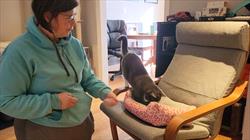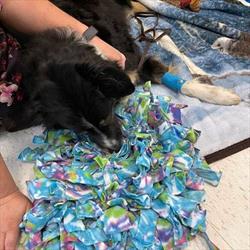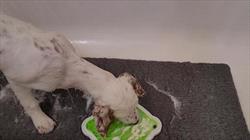Once you have selected your treatment station, it is time to start teaching your pet how to go there voluntarily. Before beginning, ensure your treatment station is ready, including treats, toys, and any items you may need for your pet’s care. It is better to have the stage prepared and not surprise your pet. Never breach your pet’s trust with unexpected items they may have had negative experiences with in the past.
Before you begin, you will need:
- a variety of treats that your pet enjoys (lickable treats, food rewards, as well as frozen stuffed food items);
- lick mats and snuffle mats;
- a clicker, and
- toys that do not cause too much excitement.
If your pet already knows how to station for other training, you are one step ahead of the game as your pet has some foundational skills. If not, it is a fun skill for all pets to learn.
The process is similar for dogs and cats. You want to keep in mind the height level you’d like your pet to be at in order to perform the necessary treatments. A small dog may need to be on an elevated station, and a cat may prefer elevation. A large dog may be out of reach if they are elevated. If the station is elevated, there should be options for your pet to safely get on and off so that they can opt out of treatment.
How to Teach Your Pet to Go to the Treatment Station
- Toss a high value treat on the station. When your pet’s paw touches the station to get the treat, mark the contact with the clicker or verbal marker. Then, one treat at a time, drop five to six small treats on the station. As they finish the last treat, toss another treat on the floor and tell them to get it.
- When they eat the treat, they will turn to look at you standing by the station. As they step toward you, drop another treat on the station and repeat the first step.
Once your pet is racing to get to the treatment station, you can then start working on keeping their arousal levels lower.
- When they come to the treatment station, mark and reward them with a food treat as soon as they arrive, and then offer them a snuffle mat, lick mat, or frozen food toy to help them settle onto the station.
- Some pets like to settle onto the station with a toy in their mouth.
- If your pet enjoys massage and petting, you can offer this option while they are on their station (only if they already enjoy it). When they are done, toss a treat off the station and release them or tell them to get it. You then want to “close” the station down. This may be by removing it completely, covering it, or otherwise managing your pet’s access to it.
Some important notes:
- Be careful not to turn the treatment station into an obedience exercise. If your pet opts to leave the station at any point, acknowledge their decision to say “no” by tossing a treat even further away and tell them to get it. Recognizing their “no” is just as important as their “yes”.
- Keep your treatment station sacred. Do not use it for other training sessions. The skills required for a treatment station are the same for other stationing behaviors but reserve the setup exclusively for care so your pet can predict what is happening.
- The treatment station can be portable and moved to different situations, such as baths.
- Don’t try to trick your pet. If they already have strong negative associations with any of the equipment, desensitize your pet to it separately from training them to love their treatment station.





